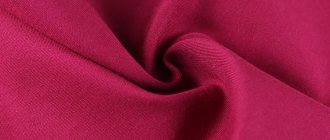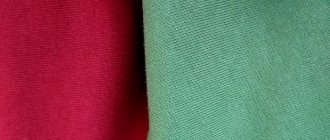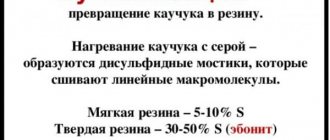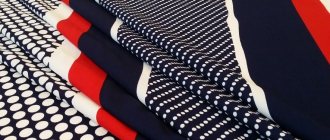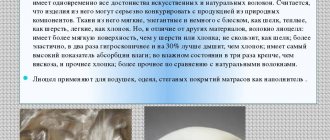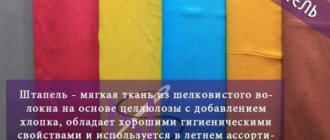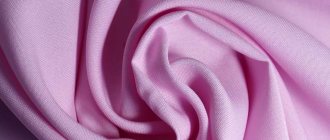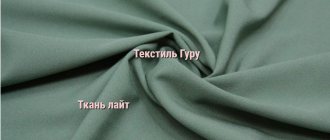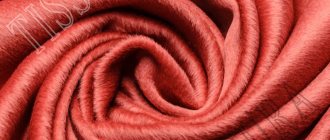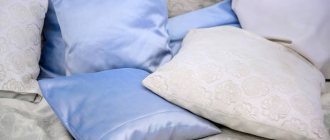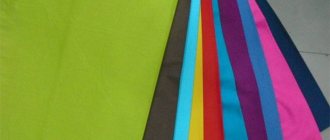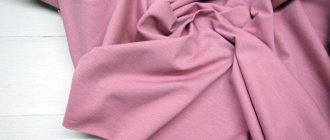Elastane (elastane, EL, lycra, lycra, spandex, spandex) - elastomeric polyurethane thread - is a synthetic thread obtained on the basis of polyurethane rubbers, similar in properties to rubber. The term “elastane” is more often used in Europe, while the term “spandex” is used in the USA and Canada. In its pure form, it is almost never used in production; it is added to other natural or synthetic fibers. Spandex is a component of many mixed fabrics: viscose, jersey, cotton, silk. Adding elastane to any fabric, cotton, viscose, silk, synthetics, makes them bielastic. That is, they easily stretch both lengthwise and crosswise. The elasticity of the product depends on how much elastane is present in a particular material.
The spandex and viscose ensemble has proven itself especially well in the sewing industry - this mixed fabric is elastic, soft and pleasant to the touch.
History of invention
At the beginning of the last century, DuPont in the USA worked on the creation of the following materials, which are still actively used today: nylon, Kevlar, napalm and Teflon. In the middle of the 20th century, the outstanding chemist Joseph Shivers, who worked for this company, conducted experiments with thermoplastic elastomer. During the observation, he noticed that the material stretched well and had high ductility after heating. Thus, an employee of the company created a high-strength fiber. The density of the fabric was 1.1-1.3 g/cm³.
Elastic
20 years later, elastane was used in girdles, corsets, tracksuits and underwear such as stockings or tights. Clothing based on this fiber quickly became popular. Elastane consists of elastomeric polyurethane threads that are synthesized from polyurethane rubbers.
Huge selection of elastane palette
Range
The range of polyurethane threads is determined by their purpose. They can serve as auxiliary when splicing (joining together) or are produced in the form of threads wrapped with other types.
Based on elastomeric threads in combination with conventional types of threads, various textile structures are produced - secondary non-uniform twisted and wrapped threads with unevenly loaded components. Elastic fabrics and knitwear of various types are made from them. Elastic threads and elastic fabrics are an indispensable material for a wide range of body-fitting textiles, including knitted sports, haberdashery and medical.
Production Features
What kind of material is elastane? The yarn is made up of flexible segments that are held together by rigid ligaments. Thanks to this, synthetic elastic fabric is highly elastic, like rubber made from rubber.
Spandex can only be created in laboratory conditions. The main raw materials are polyurethane rubbers. How to get elastane material? The methods for creating this fiber are as follows:
- transformation during a chemical process;
- creation from a specialized solution;
- injection, for example, from molten polymer.
What is elastane fabric? After the resulting threads have hardened, they are formed into bundles. Then they are washed well and dried thoroughly. After this, the threads can be wound onto spools.
Lycra and elastane: the same thing?
What is elastane and how is it different from lycra? Comparing these two concepts is tantamount to comparing the terms “fruit” and “apple”. You need to know: are elastane and lycra the same thing or not? Lycra is a segmented polyurethane that is made from man-made elastane fibers. The lycra thread stretches perfectly. It can lengthen by 6-8 times. Lycra and elastane are considered the same material.
Lycra
Note! There is no difference between these concepts, since they are the same material.
Synonyms
Polyurethane fibers are known by trade names: lycra, virin (USA), espa, neolan (Japan), spanzel (Great Britain), vorin (Italy), etc.
- Lycra is the most famous brand whose name is associated with elastane. Is a brand that was part of the DuPont company. “Lycra” gained particular popularity because almost all over the world this was the name given to any type of elastane. Invista does not condone such misconceptions and protects its brand in every possible way.
- Other brands of polyurethane fibers, among others, are Elaspan, also produced by Dorlastan and Linel.
Composition and properties
Elastane is a material made from segmented polyurethane, where flexible segments are connected to each other by strong ligaments or “bridges”. This further strengthens the strength of the threads.
2D view
What is elastane? Spandex is divided into two types:
- two-dimensional (fabric stretches only in one direction);
- four-dimensional (the material simultaneously stretches both in length and width).
4D view
The positive characteristics of this fabric are as follows:
- air passes through the lycra freely, allowing the skin to breathe;
- high wear resistance compared to other fabrics;
- clothing made from lycra is especially light, since the diameter of the threads is very small;
- the fabric retains its original appearance without changing after washing or drying;
- clothes do not fade and are resistant to contact with water;
- Thanks to the high density, a stretch effect is achieved.
How much stretch does the material have?
The elongation is very high. The thread can lengthen 8 times. At the same time, the fabric has excellent elasticity. Even after strong stretching, the clothing will return to its original shape, similar to rubber quality.
Carnival costume
Description of elastic matter
It often happens that a material is developed for one purpose, and then finds wide application in a completely different area. This is what happened with spandex. It was originally created as a rubber substitute for the military industry. But very soon it began to be used in textiles. Adding a small amount of spandex to nylon significantly improved the appearance and quality of women's tights and stockings, making them much more elastic and giving them a characteristic shine.
Then spandex began to be used to produce shapewear, swimsuits, and other clothing. But what does this fabric look like in its pure form?
Spandex refers to all types of synthetic polyurethane threads. One hundred percent spandex is a very light, but dense, durable, elastic fabric with a characteristic shine, most often in structure it is a knitted fabric. Then why is it better than elastane - this is also a highly stretchable shiny fabric? In fact, they are absolutely the same thing, and not just by description. At least, it is commonly called elastane in our country, as well as in European countries, and the name spandex is more common in North America. Its natural color is white. But since the fiber is beautifully dyed, it is produced in a wide range of colors, mainly bright, rich tones.
There are two- and four-dimensional spandex. These types are characterized by varying degrees of extensibility in length and width. Four-dimensional is the most elastic and resilient.
Combination with other materials
Cotton does not have enough elasticity, so a little elastane fiber is often added to it to make clothes more elastic. If this material is not added to cotton, then any suit will not stretch well and wrinkle a lot, even despite ironing.
If cotton fabric contains elastane, the clothing has the following properties:
- increased strength;
- increased extensibility;
- the service life of the suit is extended;
- clothes practically do not wrinkle;
- the fabric does not stretch after washing;
- “Stretch” perfectly fits the figure.
Shorts
95% cotton, 5% elastane: what kind of fabric is this?
This textile is called “satin” or “stretch cotton”. The main advantage of the elastane/cotton ratio is the “breathable” effect. Most often, business suits or dresses are made from this fabric. The material is highly durable and practical. The clothes will fit perfectly. She does not need special care.
Satin differs from other fabrics in its special shine, thanks to which any evening or cocktail dress looks luxurious. Caring for such things is quite simple. You can wash clothes in low water temperature. Strong spinning is contraindicated.
95% cotton, 5% elastane
92% cotton, 8% elastane: what kind of fabric is this?
Material with such a percentage is pleasant to the touch. Its properties are almost the same as the previous version of the fabric. It also allows the skin to breathe, and the clothes become more durable. Over time, it practically does not change its original shape. Most often, underwear or home clothes are made from this fabric. The material does not cause allergic reactions.
Viscose 95%, elastane 5%: description
The structure of viscose resembles the fibers of natural plant materials. Viscose absorbs excess moisture, while the clothing is breathable. This percentage combination of fibers allows the fabric to increase its elasticity. Statistical electricity will not accumulate, and the fabric will remain light.
Viscose 95%, elastane 5%
Application and care
Elastane in mixed fabrics is used in the production of clothing:
- for sports and dancing;
- costumes for people are made from thick spandex;
- involved in skiing and wrestling.
- Lycra is used in the manufacture of swimsuits and swimming trunks.
- Ideal for sewing carnival and circus outfits.
Any item should be cared for in accordance with the instructions. But there are several universal rules that apply to any elastane clothing.
Swimsuit
How to wash
The basic rules here are as follows:
- If washing is done by hand, then the water should be at room temperature. Washing powder is used soft for delicate fabrics. There is no need to twist or wring out the clothes too much.
- In the washing machine, select the “hand wash” or “delicate” mode. The water temperature should not exceed 40 degrees. A spin of 400 rpm is quite enough.
- white clothes are washed separately from colored items.
- No conditioners, bleaches or stain removers should be used.
How to dry
General recommendations:
- Under no circumstances should such clothes be left stretched out for a long time to dry. Prolonged drying and further storage on a hanger can deform the clothes.
- Direct sunlight should not fall on a wet item.
- dry only on a smooth surface. In this case, the thing must be straightened.
- Tumble drying is prohibited.
Costume
Important! During ironing, high iron temperature is unacceptable. The “silk” or “delicate” mode is set. Iron slightly damp clothes.
How to properly care for a rash guard and other elastane products?
- wash by hand at a water temperature of 30°C, and in automatic washing conditions in manual/delicate mode, it is preferable to turn the rash guard inside out;
- use only mild detergents, do not use bleaches or stain removers;
- do not subject the rashguard to strong squeezing;
- dry at room temperature in a straightened form, without the use of automatic dryers, indoor radiators, etc.;
- do not use an iron.
In addition to the care rules, it is necessary to mention the possible appearance of “hooks” on the rashguard. Having a particularly soft and extremely thin structure, the polyurethane fibers of the fabric are susceptible to the mechanical effects of Velcro equipment. Unfortunately, this is a weak side of many synthetic fabrics and can only be combated by securely fixing the Velcro fasteners themselves. To eliminate this unwanted contact, some athletes use short-sleeve rash guards or choose lace-up gloves. And although “hooks” on the rash guard can hardly be considered a significant drawback of this amazing material, pay attention to this and be careful.
And, of course, the very first recommendation that must be followed is the manufacturer’s requirements for caring for the rash guard. These are usually listed on the T-shirt tag.
- Spandex material - description, composition, characteristics, tailoring features and care
Pros and cons of the material
What is elastane fabric? Matter has a lot of positive properties. Here are just a few of them:
- elasticity;
- the ability of clothing to retain its original appearance even after strong stretching;
- wear resistance;
- “stretch” effect due to high density;
- It is the spandex fibers that can beautifully fit the figure, while wearing such clothes is very comfortable;
- due to the softness of the material, the mixed fabric drapes easily;
- the skin “breathes” despite the presence of synthetics in clothes;
- any stain can be easily removed with regular rinsing;
- The fabric practically does not wrinkle and does not wear out. Lumps will not roll off on such clothes.
Negative properties follow from the artificial origin of matter. The main disadvantages of synthetics are as follows:
- the likelihood of allergies, especially if the skin is hypersensitive.
- accumulation of static electricity.
- elastane practically does not absorb water. In the summer, the skin sweats a lot and overheats in such clothes, since the material itself is “non-breathable”, despite its high breathability.
- If the fabric is exposed to chlorine or direct sunlight, the clothing may become very thin and its structure will be damaged.
Leggings
Additional Information! Do not confuse polyurethane with polyester or polyamide. These materials differ in properties, composition and production method.
Kinds
Elastane is represented by such types as:
Lycra fiber. — Consider what lycra is. It is a highly elongable fiber that can withstand stretching up to 7 times its original length. Lycra threads can be transparent, translucent and white. Each of this species has its own density. Crepe elastane is a fabric with excellent drape and density. Its front side has a smooth and shiny surface, and its back side has a matte, coarse-grained surface.
Crepe elastane,
Meryl polyamide 90 elastane 10 . Meryl polyamide 90 elastane 10 is a lightweight material with excellent breathability. In addition, the material boasts high strength indicators. This type of elastane does not wrinkle, drapes perfectly and provides air movement.
Reviews
Margarita, Tobolsk: “I didn’t know about the material before, what kind of fabric is elastane? A friend advised me to buy it. I bought lycra leggings and am very pleased! Not only do they fit well, they are also easy to wash. I bought several flowers.”
Mikhail, Voronezh: “I work with children in kindergartens, and my work constantly requires various carnival costumes. I take only elastane, very cool, bright, light - a pleasure!”
Zhanna, Vologda: “I go to the gym very often, I bought a lycra suit. As long as you’re happy (your figure allows you to wear tight clothes), the suit is easy to wash.”
Positive reviews predominate in the description of the material. This is especially due to the high elasticity of the fibers. Everyone likes that clothes containing lycra are highly durable and wear-resistant. The only negative point concerns the artificial origin of the fabric.
